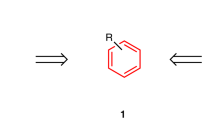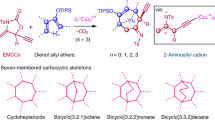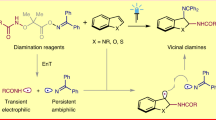Abstract
We describe the synthesis of a variety of cyclopropanes and epoxides by combining a readily accessible and isolable N,N′-diamidocarbene with a range of structurally and electronically diverse olefins and aldehydes, including electron-rich derivatives. Surprisingly, the cyclopropanation and epoxidation reactions were discovered to be rapid and thermally reversible at relatively low temperatures, two features often desired for applications that utilize dynamic covalent chemistry. In addition, a diamidocyclopropane derivative prepared via this method was hydrolysed successfully to form the corresponding linear carboxylic acid in a metal- and carbon monoxide-free hydrocarboxylation reaction. As such, diamidocarbenes are expected to find utility in the synthesis of cyclopropanes, epoxides and their derivatives, as well as in dynamic covalent chemistry applications.
This is a preview of subscription content, access via your institution
Access options
Subscribe to this journal
Receive 12 print issues and online access
$259.00 per year
only $21.58 per issue
Buy this article
- Purchase on Springer Link
- Instant access to full article PDF
Prices may be subject to local taxes which are calculated during checkout





Similar content being viewed by others
References
Reissig, H-U. & Zimmer, R. Donor–acceptor-substituted cyclopropane derivatives and their application in organic synthesis. Chem. Rev. 103, 1151–1196 (2003).
McGarrigle, E. M. & Gilheany, D. G. Chromium- and manganese-salen promoted epoxidation of alkenes. Chem. Rev. 105, 1563–1602 (2005).
Carson, C. A. & Kerr, M. A. Heterocycles from cyclopropanes: applications in natural product synthesis. Chem. Soc. Rev. 38, 3051–3060 (2009).
Wessjohann, L. A. & Brandt, W. Biosynthesis and metabolism of cyclopropane rings in natural products. Chem. Rev. 103, 1625–1647 (2003).
Marco-Contelles, J., Molina, M. T. & Anjum, S. Naturally occurring cyclohexane epoxides: sources, biological activities, and synthesis. Chem. Rev. 104, 2857–2899 (2004).
Rademacher, P. Photoelectron spectra of cyclopropane and cyclopropene compounds. Chem. Rev. 103, 933–975 (2003).
Herges, R. Topology in chemistry: designing Möbius molecules. Chem. Rev. 106, 4820–4842 (2006).
Lebel, H., Marcoux, J-F., Molinaro, C. & Charette, A. B. Stereoselective cyclopropanation reactions. Chem. Rev. 103, 977–1050 (2003).
Pellissier, H. Recent developments in asymmetric cyclopropanation. Tetrahedron 64, 7041–7095 (2008).
Moss, R. A. in Carbene Chemistry (ed. Bertrand, G.) 57–101 (Marcel Dekker, 2002).
Jones, M. Jr & Moss, R. A. in Reactive Intermediate Chemistry (eds Moss, R. A., Platz, M. S. & Jones, M. Jr) Ch. 7, 273–328 (Wiley-Interscience, 2004).
Cheng, Y. & Meth-Cohn, O. Heterocycles derived from heteroatom-substituted carbenes. Chem. Rev. 104, 2507–2530 (2004).
Wang, J., Burdzinski, G., Kubicki, J. & Platz, M. S. Ultrafast UV-vis and IR studies of p-biphenylyl acetyl and carbomethoxy carbenes. J. Am. Chem. Soc. 130, 11195–11209 (2008).
Zhang, Y., Kubicki, J. & Platz, M. S. Ultrafast UV-visible and infrared spectroscopic observation of a singlet vinylcarbene and the intramolecular cyclopropenation reaction. J. Am. Chem. Soc. 131, 13602–13603 (2009).
Baceiredo, A., Bertrand, G. & Sicard, G. Synthesis of the first α-diazo phosphines. Phosphorous–carbon multiple-bond character of phosphinocarbenes. J. Am. Chem. Soc. 107, 4781–4783 (1985).
Igau, A., Baceiredo, A., Trinquier, G. & Bertrand, G. [Bis(diisopropylamino)phosphino]trimethylsilylcarbene: a stable nucleophilic carbene. Angew. Chem. Int. Ed. 28, 621–622 (1989).
Khramov, D. M., Rosen, E. L., Lynch, V. M. & Bielawski, C. W. Diaminocarbene[3]ferrocenophanes and their transition-metal complexes. Angew. Chem. Int. Ed. 47, 2267–2270 (2008).
Lavallo, V. et al. Synthesis, reactivity, and ligand properties of a stable alkyl carbene. J. Am. Chem. Soc. 126, 8670–8671 (2004).
Siemeling, U. et al. N-heterocyclic carbenes which readily add ammonia, carbon monoxide and other small molecules. Chem. Sci. 1, 697–704 (2010).
Vignolle, J., Cattoën, X. & Bourissou, D. Stable noncyclic singlet carbenes. Chem. Rev. 109, 3333–3384 (2009).
Dröge, T. & Glorius, F. The measure of all rings – N-heterocyclic carbenes. Angew. Chem. Int. Ed. 49, 6940–6952 (2010).
Melami, M., Soleilhavoup, M. & Bertrand, G. Stable cyclic carbenes and related species beyond diaminocarbenes. Angew. Chem. Int. Ed. 49, 8810–8849 (2010).
Martin, D., Soleilhavoup, M. & Bertrand, G. Stable singlet carbenes as mimics for transition metal centers. Chem. Sci. 2, 389–399 (2011).
Enders, D. et al. Preparation, structure, and reactivity of 1,3,4-triphenyl-4,5-dihydro-1H-1,2,4-triazol-5-ylidene, a new stable carbene. Angew. Chem. Int. Ed. 34, 1021–1023 (1995).
Goumri-Magnet, S., Kato, T., Gornitzka, H., Baceiredo, A. & Bertrand, G. Stereoselectivity and stereospecificity of cyclopropanation reactions with stable (phosphanyl)(silyl)carbenes. J. Am. Chem. Soc. 122, 4464–4470 (2000).
Krysiak, J. et al. The first asymmetric cyclopropanation reactions involving a stable carbene. J. Org. Chem. 66, 8240–8242 (2001).
Krysiak, J. et al. Stable optically pure phosphino(silyl)carbenes: reagents for highly enantioselective cyclopropanation reactions. Chem. Eur. J. 10, 1982–1986 (2004).
Martin, D. et al. Theoretical and experimental investigation of the basicity of phosphino(silyl)carbenes. J. Org. Chem. 70, 5671–5677 (2005).
Illa, O., Álvarez-Larena, Á., Baceiredo, A., Branchadell, V. & Ortuño, R. M. Highly stereoselective and easy synthesis of enantiopure phosphoranyl oxiranes. Tetrahedron: Asymmetry 18, 2617–2620 (2007).
Illa, O., Bagan, X., Baceiredo, A., Branchadell, V. & Ortuño, R. M. Understanding the π-facial diastereoselectivity in the addition of chiral diaminophosphino(silyl)carbenes to activated olefins. Tetrahedron: Asymmetry 19, 2353–2358 (2008).
Hudnall, T. W. & Bielawski, C. W. An N,N′-diamidocarbene: studies in C–H insertion, reversible carbonylation, and transition-metal coordination chemistry. J. Am. Chem. Soc. 131, 16039–16041 (2009).
César, V., Lugan, N. & Lavigne, G. Reprogramming of a malonic N-heterocyclic carbene: a simple backbone modification with dramatic consequences on the ligand's donor properties. Eur. J. Inorg. Chem. 361–365 (2010).
Hudnall, T. W., Moorhead, E. J., Gusev, D. G. & Bielawski, C. W. N,N′-diamidoketenimines via coupling of isocyanides to an N-heterocyclic carbene. J. Org. Chem. 75, 2763–2766 (2010).
Hudnall, T. W., Moerdyk, J. P. & Bielawski, C. W. Ammonia N–H activation by a N,N′-diamidocarbene. Chem. Commun. 46, 4288–4290 (2010).
Braun, M., Frank, W., Reiss, G. J. & Ganter, C. An N-heterocyclic carbene with an oxalamide backbone. Organometallics 29, 4418–4420 (2010).
Hobbs, M. G. et al. The influence of electron delocalization upon the stability and structure of potential N-heterocyclic carbene precursors with 1,3-diaryl-imidazolidine-4,5-dione skeletons. New J. Chem. 34, 1295–1308 (2010).
Hudnall, T. W., Tennyson, A. G. & Bielawski, C. W. A seven-membered N,N′-diamidocarbene. Organometallics 29, 4569–4578 (2010).
Moerdyk, J. P. & Bielawski, C. W. Olefin metathesis catalysts containing N,N′-diamidocarbenes. Organometallics 30, 2278–2284 (2011).
Wasserman, H. H., Clark, G. M. & Turley, P. C. Recent aspects of cyclopropanone chemistry. Top. Curr. Chem. 47, 73–156 (1974).
Olah, G. A. & Molnar, Á. In Hydrocarbon Chemistry (ed. Lagowski, J. J.) Ch. 7, 371–395 (Wiley-Interscience, 2003).
Linstead, R. P. & Whalley, M. Conjugated macrocycles. Part XXII. Tetrazaporphin and its metallic derivatives. J. Chem. Soc. 4839–4846 (1952).
Moss, R. A. & Huselton, J. K. Dimethoxycarbene: stereospecificity in the additions of a nucleophilic carbene to β-deuteriostyrenes. J. Chem. Soc. Chem. Commun. 950–951 (1976).
Mendez, F. & Garcia-Garibay, M. A. A hard–soft acid–base and DFT analysis of singlet–triplet gaps and the addition of singlet carbenes to alkenes. J. Org. Chem. 64, 7061–7066 (1999).
Lecea, B. et al. Theoretical study on the mechanism of the [2+1] thermal cycloaddition between alkenes and stable singlet (phosphino)(silyl)carbenes. J. Org. Chem. 72, 357–366 (2007).
Mukai, T., Nakazawa, T. & Isobe, K. Thermal decomposition of troponetosylhydrazone. Tetrahedron Lett. 565–569 (1968).
Jones, W. M., Hamon, B. N., Joines, R. C. & Ennis, C. L. Stereochemistry of the addition of cycloheptatrienylidene to electron deficient double bonds. Tetrahedron Lett. 3909–3912 (1969).
Hamaguchi, M., Matsubara, H. & Nagai, T. Reaction of vinylcarbenoids with benzaldehydes: formation of vinylcarbonyl ylides followed by ring closure to oxiranes and dihydrofurans. J. Org. Chem. 66, 5395–5404 (2001).
Dolbier, W. R. Jr & Battiste, M. A. Structure, synthesis, and chemical reactions of fluorinated cyclopropanes and cyclopropenes. Chem. Rev. 103, 1071–1098 (2003).
Lehn, J-M. From supramolecular chemistry towards constitutional dynamic chemistry and adaptive chemistry. Chem. Soc. Rev. 36, 151–160 (2007).
Hunt, R. A. R. & Otto, S. Dynamic combinatorial libraries: new opportunities in systems chemistry. Chem. Commun. 47, 847–858 (2011).
Acknowledgements
We are grateful to the National Science Foundation (CHE-0645563), the Robert A. Welch Foundation (F-1621) and the Sloan Foundation for their support.
Author information
Authors and Affiliations
Contributions
C.W.B. and J.P.M. conceived and designed the experiments, and co-wrote the paper. J.P.M. performed the experiments and analysed the data. Both authors discussed the results and commented on the manuscript.
Corresponding author
Ethics declarations
Competing interests
The authors declare no competing financial interests.
Supplementary information
Supplementary information
Supplementary information (PDF 10243 kb)
Supplementary information
Crystallographic data for compound 2e. (CIF 19 kb)
Supplementary information
Crystallographic data for compound 2j. (CIF 20 kb)
Supplementary information
Crystallographic data for compound 2k. (CIF 35 kb)
Supplementary information
Crystallographic data for compound 2m. (CIF 17 kb)
Supplementary information
Crystallographic data for compound 2o. (CIF 32 kb)
Supplementary information
Crystallographic data for compound 3a. (CIF 18 kb)
Supplementary information
Crystallographic data for compound 4b. (CIF 31 kb)
Rights and permissions
About this article
Cite this article
Moerdyk, J., Bielawski, C. Diamidocarbenes as versatile and reversible [2 + 1] cycloaddition reagents. Nature Chem 4, 275–280 (2012). https://doi.org/10.1038/nchem.1267
Received:
Accepted:
Published:
Issue Date:
DOI: https://doi.org/10.1038/nchem.1267
This article is cited by
-
Thiazol-2-ylidenes as N-Heterocyclic carbene ligands with enhanced electrophilicity for transition metal catalysis
Communications Chemistry (2022)
-
A crystalline monosubstituted carbene
Nature Chemistry (2018)
-
An overview of N-heterocyclic carbenes
Nature (2014)
-
Computational comparison of the kinetic stabilities of diamino- and diamidocarbenes in the 1,2-H shift reaction
Journal of Molecular Modeling (2013)
-
A comparison of diamino- and diamidocarbenes toward dimerization
Journal of Molecular Modeling (2013)



